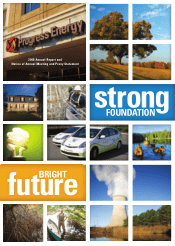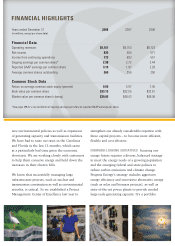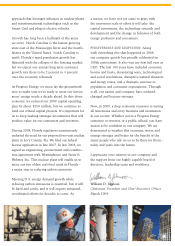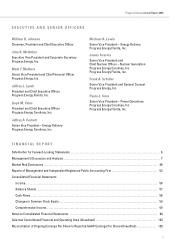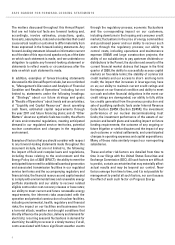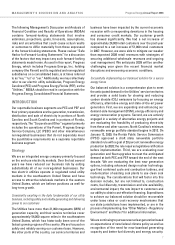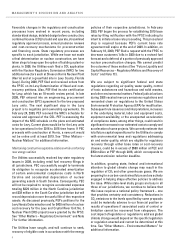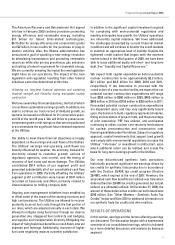Progress Energy 2008 Annual Report Download - page 9
Download and view the complete annual report
Please find page 9 of the 2008 Progress Energy annual report below. You can navigate through the pages in the report by either clicking on the pages listed below, or by using the keyword search tool below to find specific information within the annual report.
Progress Energy Annual Report 2008
7
The following Management’s Discussion and Analysis of
Financial Condition and Results of Operations (MD&A)
contains forward-looking statements that involve
estimates, projections, goals, forecasts, assumptions,
risks and uncertainties that could cause actual results
or outcomes to differ materially from those expressed
in the forward-looking statements. Please review “Safe
Harbor for Forward-Looking Statements” for a discussion
of the factors that may impact any such forward-looking
statements made herein. As used in this report, Progress
Energy, which includes Progress Energy, Inc. holding
company (the Parent) and its regulated and nonregulated
subsidiaries on a consolidated basis, is at times referred
to as “we,” “us” or “our.” Additionally, we may collectively
refer to our electric utility subsidiaries, Progress Energy
Carolinas (PEC) and Progress Energy Florida (PEF), as the
“Utilities.” MD&A should be read in conjunction with the
Progress Energy Consolidated Financial Statements.
INTRODUCTION
Our reportable business segments are PEC and PEF and
their primary operations are the generation, transmission,
distribution and sale of electricity in portions of North
Carolina and South Carolina and in portions of Florida,
respectively. The “Corporate and Other” segment primarily
includes the operations of the Parent, Progress Energy
Service Company, LLC (PESC) and other miscellaneous
nonregulated businesses that do not separately meet
the quantitative requirements as a separate reportable
business segment.
Strategy
We are an integrated energy company primarily focused
on the end-use electricity markets. Over the last several
years we have reduced our business risk by exiting
substantially all of our nonregulated businesses. Our
two electric utilities operate in regulated retail utility
markets in the southeastern United States and have
access to attractive wholesale markets in the eastern
United States, which we believe positions us well for
long-term growth.
Consistently excelling in the daily fundamentals of our utility
business, including safely and reliably generating and delivering
power to our customers
The Utilities have more than 21,000 megawatts (MW) of
generation capacity, and their service territories cover
approximately 54,000 square miles in the southeastern
United States, which has historically been one of the
fastest-growing regions of the country. We are focused on
safely and reliably serving our customer base. However,
like other parts of the country, our service territories and
business have been impacted by the current economic
recession with corresponding downturns in the housing
and consumer credit markets. Our customer growth
has slowed significantly. We had a net increase of
approximately 24,000 retail customers over the past year
compared to a net increase of 51,000 retail customers
in 2007. However, we were able to mitigate our weaker
than expected 2008 retail revenues with strategies of
securing additional wholesale revenues and ongoing
cost management. We anticipate 2009 will be another
challenging year given the recent financial market
disruptions and worsening economic conditions.
Successfully implementing our balanced solution for a secure
energy future
Our balanced solution is a comprehensive plan to meet
the anticipated demand in the Utilities’ service territories
and provide a solid basis for slowing and reducing
carbon dioxide (CO
2
) emissions by focusing on energy
efficiency, alternative energy and state-of-the-art power
generation. First, we are expanding and enhancing our
demand-side management (DSM), energy-efficiency and
energy conservation programs. Second, we are actively
engaged in a variety of alternative energy projects and
are evaluating the feasibility of producing electricity
from these and other sources. North Carolina’s minimum
renewable energy portfolio standard begins in 2012. On
January 12, 2009, the Florida Public Service Commission
(FPSC) approved a draft state renewable portfolio
standard rule with a goal of 20 percent renewable energy
production by 2020; the rule requires legislative ratification
before implementation. Third, we are evaluating new
generation and fleet upgrades to meet the anticipated
demand at both PEC and PEF toward the end of the next
decade. We are evaluating the best new generation
options, including advanced design nuclear technology,
gas-fired combined cycle and combustion turbines, and
modernization of existing coal plants to use clean coal
technology. The considerations that will factor into this
decision include, but are not limited to, construction
costs, fuel diversity, transmission and site availability,
environmental impact, the rate impact to customers and
our ability to obtain cost-effective financing. Expenditures
to achieve our balanced solution should be recoverable
under base rates or cost-recovery mechanisms that
our state jurisdictions have implemented, or are in the
process of implementing. See “Other Matters – Regulatory
Environment” and Note 7 for additional information.
We are continuing to pursue new nuclear generation based
on expectations of new federal climate policy as well as
recognition of the need for new baseload generating
capacity and better fuel diversity and energy security.
MANAGEMENT’S DISCUSSION AND ANALYSIS

